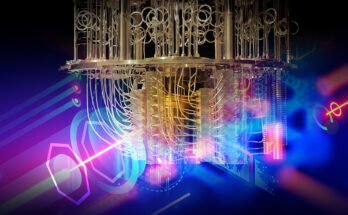During the last few years there has been one company that has continually resounded with respect to the future of computing; NVIDIA. Once a manufacturer of graphics cards used by gamers, now, almost overnight (and then some), Nvidia finds itself at the epicenter of the hardware used to perform modern artificial intelligence. The dominance there is not coincidental it is the result of smart architecture decisions, a healthy software ecosystem, huge needs to use in data centers and a product development tempo that has been ahead of its competitors. However, with vast success, there arise some challenges: geopolitical limitations, increasing regulatory interest, and competitors slowly narrowing the gaps between each other and the giant. This paper decodes how NVIDIA got to its position of control, what dominance can practically be, and what may convulse the burial place of the last.
GPUs to AI accelerators: an architectural head start
NVIDIA owes its original power to the graphics processing units (GPUs) chip that is optimized to do many calculations simultaneously and render images. The same parallelism did turn out to fit the massive matrix math embodied in the essence of contemporary deep learning like a glove. NVIDIA expected that change and reacted quickly. Instead of positioning its GPUs as gaming toys, it developed a stack of software (primarily CUDA, cuDNN, and the related libraries) that abstracted programmability of its GPUs and generally made them quite amenable to scientific-computation and machine-learning purposes. That hardware with developer tools combination proved successful: as the AI research community and cloud providers would adopt NVIDIA GPUs in large numbers, this led to software, frameworks, and optimized models being written to use them, which further promoted their use, and hence the continued use of their hardware.
Since the ecosystem was established by the time other silicon vendors moved to market their AI-centric silicon, NVIDIA was able to rapidly expand production and iterate rates, but maintain a humongous, sticky customer base amongst hyperscale cloud providers, enterprise center data centers, and research laboratories.
The figures: data-center sales and percentage market coverage
The magnitude of success of NVIDIA can be seen in the financials of the company. In its financial filings, NVIDIA has consistently reported huge and consistently accelerating revenue on its data-center segment — the business that markets the GPU and systems that cloud operators utilize to train and do inference of AI models. As an example, NVIDIA registered a quarterly revenue of 44.1 billion as of April 27, 2025, with the company realizing data-center revenue of 39.1 billion the same quarter. Those numbers indicate what percentage of the company topline is now tied to AI loads as opposed to gaming or PCs.
NVIDIA Newsroom
Over on the discrete GPU side, the mostly enthusiast and gamer cards that people get, independent market trackers and surveys are still showing NVIDIA with an insurmountable lead. According to the monthly hardware survey issued by Steam, which gets a very large share of PC users, by mid-2025, about 75 percent of discrete video cards ever detected are NVIDIA computers. Other market reports, including ones that add or aggregate data and report it through sites like Toms Hardware based on Jon Peddie Research surveys peg NVIDIAs market share of the discrete desktop GPU segment at comfortably over 80-90% in recent quarters. Those figures highlight how NVIDIA today monopolizes the consumer-based GPU market as well as the vastly more lucrative AI accelerator market.
Steam Store
Tom’s Hardware
Product line: staying on the demand curve
NVIDIA was not lucky to get where they are. A consistent rhythm of new architectures (starting with Pascal and Volta to Ampere, Hopper, and Blackwell), as well as specialist products (such as the H100 and later Blackwell-series accelerators) enabled the company to continue increasing per-watt performance and raw throughput when such features mattered most to buyers. It also has extended product families to cater to varying combinations of needs: mainstream GeForce cards to gamers, professional GPUs to workstations, and custom DGX and HGX systems to hyperscalers.
Importantly, NVIDIA does not only deal with chips; it deals with full stack products. The company ships GPUs bundled with networking (Mellanox-based interconnect), software toolchains, reference racks and consulting terms to enable cloud providers. The fact that such systems approach simplifies procurement and allows NVIDIA to capture more value than a supplier who solely sells silicon makes it easier to make purchasing decisions among such large customers.
The ecosystem impact: software, venture and capture
It is possible to copy hardware; an ecosystem is more difficult to imitate. The CUDA platform, ecosystem of speed-optimized libraries, and good relations with model developers make much of the AI stack to be tacitly optimized towards NVIDIA hardware. When a research group releases a model or benchmark the codes and performance scripts are implemented in CUDA-compatible GPUs. This forms a form of lock-in the process of changing accelerators normally involves porting effort, retraining the performance engineers and even a rewrite of large portions of the stack.
RIDP also matters in terms of partnerships. Powerful cloud providers, the same companies that host models and services which millions of people access, invested phenomenally in NVIDIA-based servers. That kind of relationship establishes high-velocity demand, which is difficult to be matched by other new entrants in the short-term.
Rivalry, limitations and game of world chess board
The status that NVIDIA has assumed has opened the door to competition as well as regulators. Both AMD and Intel have been promoting more AI-focused GPUs and accelerators and various startups and custom in-house processing (at hyperscalers) have tried to wear NVIDIA down at their heels. In certain precincts AMD has been able to re-regain a degree of consumer GPU market-share, and is making a go of data-center play; however the acceleration and scope of NVIDIA deployments continues to make it the benchmark of the market.
Tom’s Hardware
There is emerging threat of geopolitics. Export control and national security issues have influenced the ability to ship advanced AI accelerators and where it can be shipped. As reported in 2025 there were also reports and official statements regarding that the sale of some high-end chips to China and elsewhere would be limited, and there are talks of sharing of revenue and even on export compliance. The dynamics cause friction and have the effect to dull demand in big markets. To take a specific example, there were reports of a deal that will compel firms to record some revenue arising out of sales made in China under new standards a reminder that NVIDIA global supply and sales model will deal with more than silicon game.
Reuters
The regulatory and ethical fire On the potential costs Of medicines undone On the potential costs Of medicines undone
Market leaders will be noticed sooner or later. The fact that NVIDIA occupies a central place in the AI hardware supply chain leads to the concerns related to power concentration, supply chain vulnerability, and the existence of a single source of supply that can bring a significant systemic risk. These problems are becoming more sensitive with policymakers and competition authorities. Even in the absence of an immediate antitrust intervention, both government and private firms will have an interest in ensuring that they do not suffer choke points in supply, a factor that would open up the door to competitors.
This is accompanied by ethical considerations as well. The easier and quicker the hardware is, the larger and more competent the AI models. It can create gains (medical research, climatic modeling, automating) and losses (abuse, spying, labor displacement). NVIDIA is inevitably a part of that industry-wide discussion as the leading bringer of compute to large models.
Is dominance unassailable?
Not even a market leader is invulnerable. A number of reasons are likely to undermine the standing of NVIDIA in the long run:
Alternative architectures: New accelerator designs which are highly optimized to the given sparse computation, lower-precision inference, or transformer-like workloads may be cheaper or more energy-efficient in comparison with general-purpose GPUs, motivating a shift of customers.
Open-source CPU and GPU: In the event of an open ecosystem that reduced both the cost and the friction involved in abandoning CUDA, vendor lock-in would be diminished, especially should a large ecosystem of open-source hardware and software around a CPUs and GPUs come to dominate it.
Chain and manufacturing constraints: the capacities of the leading foundries are finite. The supply limitations may hinder the expansion of NVIDIA in case competencies attain additional manufacturing capacity or in the event there is increased trade protectionism due to geopolitical factors.
Diversification of customers: Hyperscalers may go all-in on in-house ASICs (already done by some) on specific loads lowering their exposure to NVIDIA.
Nevertheless, all these are not immediate threats. They need capital, time and persuading the ecosystem (researchers, developers, tooling vendors) to abandon deeply ingrained ways of working.
The reason why investors, businesses and researchers are interested
To investors, the expansion and the following shrinking of NVIDIA have meant extremely remarkable gains/losses in market capitalization making it one of the most precious technological companies at multiple instances in 20242025. To enterprises, NVIDIA accelerators have evolved beyond a specialized tool to a strategic item of purchase: as a bank seeks to benefit speedier, or an online service seeks to offer generative AI features, access to accelerators with performance capabilities counts. To a researcher this translates to reduced iteration times and launching experiments with a reduced threshold.
That proximity, however, establishes some forms of dependencies as well: the expense of training huge models can increase in lock-step with the price of the hardware and the business model of several AI companies is closely connected to access to NVIDIA equipment.
A practical glimpse to the future
Power can be a very slippery term. NVIDIA position today is on the crossroad of software, hardware and enterprise demand more so than the other chippers in history. The amount of data-center demand and revenue concentration around AI accelerators is indicated by the recent quarterly results of the firm, an essential benchmark to anyone who seeks to comprehend the contemporary compute economy.
NVIDIA Newsroom
+1
But markets change. There will be a closer focus on concentration and exports by the regulators, increased competition especially due to customer hedging (exploring alternate architecture and suppliers). The fight between hardware vendors to control the next generation of AI will be determined by efficiency (compute per dollar), programmability, developer ecosystem, and –more and more- geopolitics and supply-chain constraints.
Outcome: Supremacy, not perseverance
NVIDIA dominates is a fair reflection of 2024-2025: large market share in discrete GPUs, outsize share of the data-center accelerator market, and financials that show how a surge in demand in persistent AI and compute is adding to the bottom line. It is that dominance because of architectural thinking, a strong software ecosystem, and strong connections to the cloud providers and enterprises. However, power and permanence are two different issues. There are several technological advances, regulatory pressure, supply-chain shifts, and customer procurement strategy changes which are all capable of recreating the landscape.
At this point, anything regarding AI compute is built or purchased by NVIDIA, and the simple reason is that it is safe, high-performing and well-supported, and that is exactly why NVIDIA products are everywhere. Whether it will still be true in five years will not have much to do with any one product launch, nor the threat of other supplier threat advances, but with whether the confluence of performance, software and scale that NVIDIA has developed can be replicated, and with whether such a dominant position of a single supplier can be countenanced by the political and economic landscape.




